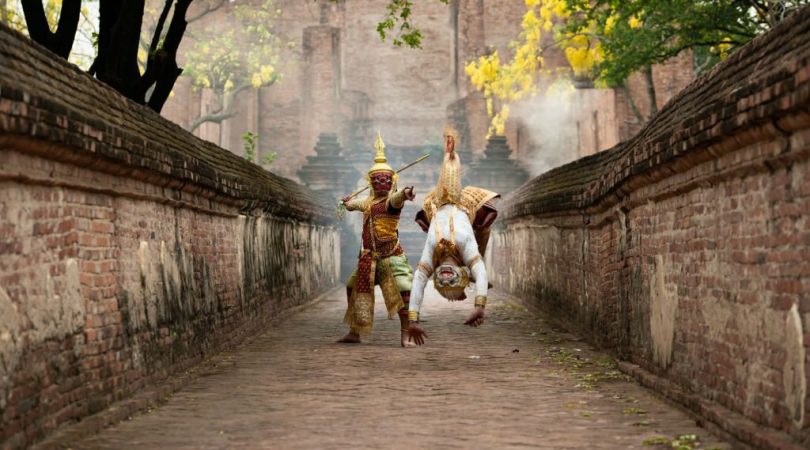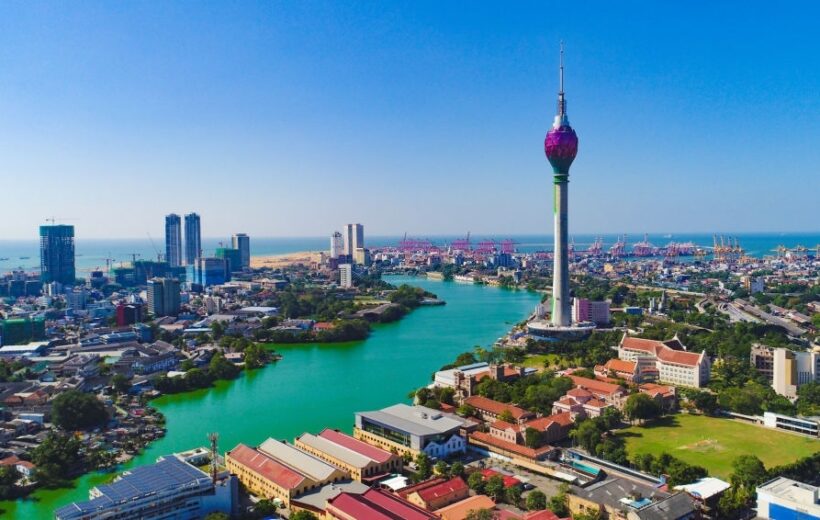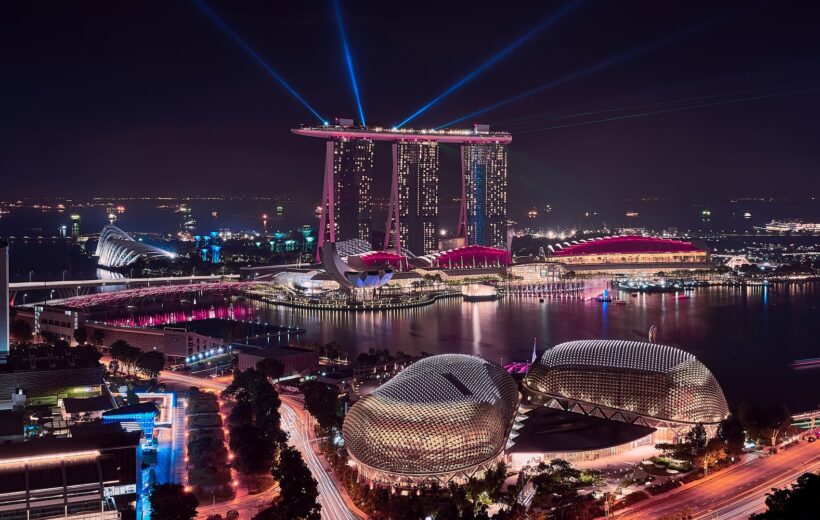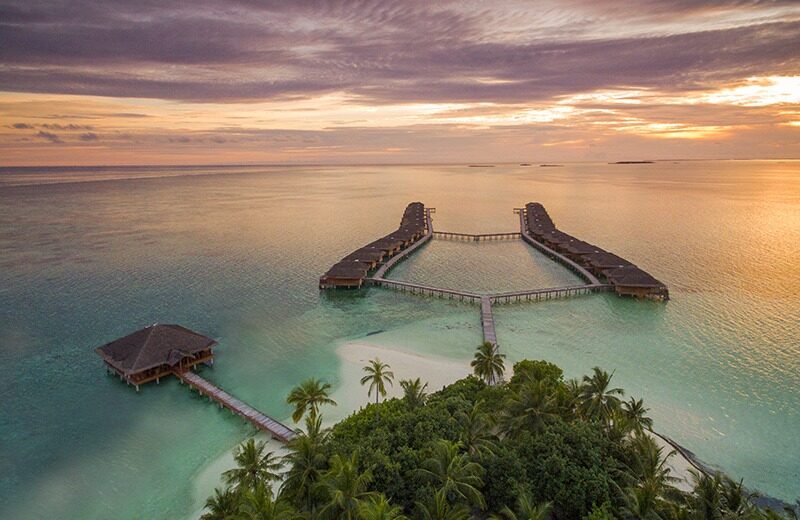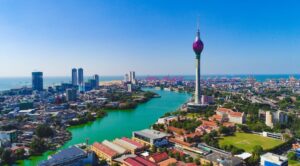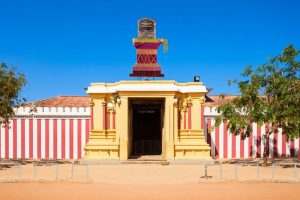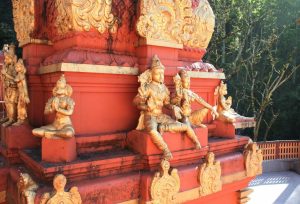Price
Duration
Max People
Min Age
Tour Type
Reviews
No reviews yetOverview
Sri Lanka is home to various temples and locations associated with the age-old Sanskrit epic of the Ramayana. On this 7-day private vacation that includes hotels and a private chauffeured vehicle, you can make a pilgrimage to these sacred locations without having to manage local buses or trains. Visit Hindu temples such as Manavari in Chilaw, Ashok Vitaki, and other spots steeped in Ramayana legend, and learn details about the ancient chronicle from your driver-guide that you might miss if you go alone.
Spotlights
visit Sri Lanka's famed Ramayana locations and temples. With ease, follow the Ramayana trail: Via chauffeured car with a driver-guide Join pilgrims at Ashok Vitaki, Manavari Kovil, and other spectacular locations.
Included/Excluded
- Transfers in Private Vehicle
- Meal,Breakfast,Lunch, Dinner (Vegetarian and Jain Meals Arrangements)
- Local Sightseeing as per tour
- Local mobile sim card
- Accommodation on twin sharing basis
- English speaking driver
- Government Taxes/VAT/ Service Charges
- Private National Guide Service for Ramayana Trail
- Departure Taxes
- Entry Fees
- Personal and incidental expenses
- Anything not mentioned in inclusions
Tour Plan
Day 1-Dambulla : Transfer to Dambulla, stopping in Chillaw to see the Munneswaram and Manavari Temples.
Hindu temple at Munneshwaram
Real Lanka agents will meet you at the airport and transport you to Dambulla/Habarana.En route, stop at Munneshwaram, Manaveri, and Sigiriya/Cobra Hooded Cave. Munneshwaram Temple: Munneshwaram is the name of Lord Shiva's initial temple (Munnu + Eswaram). After winning the fight, Lord Rama and Sita rode on one of Ravana's vimanas to Ayodhya. Because he had killed Ravana, a Brahmin, he thought he was being pursued by Bramhaasthi dosham (a evil black shadow). He felt the vimana vibrating as it passed over Munneshwaram, and in Munneshwaram realised the Brahmaasthi Dosham was not pursuing him at this time. At this point, he stops the Vimana and pleads Lord Shiva for help.
Manaveriya Manaveri Temple:
Manaveri was the first lingam built and prayed to by Lord Rama, and it is still known as Ramalinga Shivan. The only other lingam in the world named after Lord Rama is Rameshwaram.
Sigiriya Sigiriya's Ancient Rock Fortress/Cobra Hooded Cave:
It is a natural geological feature that is part of the well-known Sigiriya rock. According to the entries in the Palm Leaf Book, Ravana Watha, Sigiriya was built on the orders of King Visthavasa, King Ravana's father. The blue-hued lady in the frescoes represents the Yakka tribe, while the other ladies represent the Naga, Deva, and Gandabhbha tribes, according to Ravana Watha. King Ravana is reported to have imprisoned Sita in Cobra Hood Cave. Its roof is covered in prehistoric drawings. There is a clear link between Sita and the cave with the inscription 'Parumaka naguliya lene', which relates to Sita.
Accommodation: Dinner and overnight stay in Dambulla/Habarana hotel
Meals: Dinner
Day 2- Transfer to Trincomalee - On the way Visit Ritigala Mountain, Thirukoneswaram Temple, and spend the night at Trincomalee.
Ritigala Forest Monastery
Check out of the Dambulla/Habarana hotel after breakfast. Transfer to Ritigala Sanjeewanee mountain, where you can tour the site as well as the Buddhist monastery. On the way to Trincomalee, stop at the Kanniya hot springs for a bath and lunch at a neighbouring restaurant. In Trincomalee, see the Thirukoneswaram temple/Shankari Devi temple. Ritigala Sanjeewanee Mountain: It is believed that this mountain is a fragment of the Himalayas that Lord Hanuman dropped here by accident. According to the Hindu epic Ramayanaya, King Ravana kidnapped Sita and imprisoned her here. Lord Rama's forces arrived on this island to fight King Ravana.Lord Rama's brother, Prince Lakshmana, was seriously hurt in battle, so Hanuman carried back a chunk of the Himalayas to cure his wounds with medical herbs found on the Himalayas.
Kanniya Thermal Springs Kanniya hot water springs:
According to one tradition, this is where King Ravana performed the funeral rites for his mother. When he couldn't get water to complete the rites, he pierced his Trishula into the earth seven times. Water quickly began to pour out. When Ravana's rage subsided, the extremely hot water cooled to its current temperature. Each well's water temperature is different from the next.
Thirukoneswaram Kovil Thirukoneshwaram Temple:
Thiru Koneswaram was established by Rishi Agastya on the orders of Lord Shiva, who was moved by King Ravana's devotion. In this regard, this location is exceptional in that the Lord built a temple for his devotee as a reward for his devotion. Lord Rama is said to have prayed here to remove the curse of killing Ravana, who was a Brahmin, which is known as Brahmahasthi Dosham. Shankari Shakthi Peetam Temple: A little shrine adjacent to Koneswaram temple holds some significance for Hindu pilgrims. The original Shankari Devi temple, thought to have been built by Ravana, was the first on Adi Shankara's list of Ashta Dasha (18) Shakti Pitas.
However, the entire cliff was demolished by Portuguese cannon rounds, leaving only a commemorative structure in its place. And it is thought that the Goddess's original idol has been preserved, replaced, and is now adored in this nearby new Shankari Devi temple.
Accommodation: Dinner and overnight stay In Trincomalee hotel.
Meals: Breakfast Lunch Dinner
Day 3- Transfer to Kandy - En route, visit Dambulla Cave Temple - Explore Kandy - Stay in Kandy for the night
Dambulla Cave Temple
After breakfast, drive to Kandy, stopping along the way to see the Dambulla Cave Temple. Visit Spice Garden, then travel to Kandy. Kandy city tour followed by Sri Lankan folk dance in Kandy. Dambulla Cave and the Golden Temple: Rangiri Dambulla Cave Temple is a live Buddhist complex comprised of five cave shrines. There is a massive rock that was cut out by hand thousands of years ago to create a large type of "cave." There are five distinct rooms within this cave, each with its own temple, which you can explore while visiting. Inside the caves, the ceilings were intricately decorated with pictures of the Lord Buddha and Bodhisattvas, as well as numerous gods and goddesses.
Kandy, Sri Lanka's cultural capital and a UNESCO World Heritage Site, is set in a valley encircled by mountain rings. The only decorative lake in Sri Lanka, Kiri Muhuda (Sinhala: the sea of milk), is located right in the heart of Kandy's city centre. The Temple of the Sacred Tooth Relic (Sri Dalada Maligawa) is the most famous attraction in Kandy. This lovely city is endowed with numerous attractions such as the Royal Botanical Gardens, Kandy Lake, the Bahirawakanda temple for spiritual searchers, the Udawattekele Sanctuary, the Ceylon Tea Museum - a tea lover's delight, Wales Park - for a calm stroll, and many more.
Accommodation: Dinner and overnight stay in Kandy Hotel.
Meals: Breakfast Lunch Dinner
Day 4-Kandy to Nuwaraeliya - Visit Sri Bhakta Hanuman Temple,Tea Plantation, Ramaboda Waterfall, Nuwara Eliya city tour
Temple of Sri Baktha Hanuman Sri Bhaktha Hanuman temple:
It is said that Sri Hanumanji first set foot in these sacred hills while searching for Sita. This huge temple is now a great landmark, and the moola murti is a 16-foot-tall idol of Lord Hanuman.
Nuwara Eliya is in Sri Lanka. Sri Lankan tea plantation: The Ceylon tea business employs 1.5 million Sri Lankans directly and/or indirectly and contributes billions of dollars to the Sri Lankan economy each year. James Taylor, a young Scotsman, brought tea to Sri Lanka in 1867. Ceylon tea has a tremendous reputation for being the greatest tea in the world, and it is the world's fourth largest tea grower. You may sample the original Ceylon fresh tea and observe the tea process in action, including how the green tea leaves end up in drinking tea via several procedures such as withering (drying), rolling, fermentation, oxidising, drying again, sorting, and bulk packing.
Nuwara Eliya, also known as "Little England," is one of the country's coldest cities. There are signs of British influence all across Nuwara Eliya, including as red telephone boxes and well-tended hedgerows. The town's high elevation provides visitors with breathtaking views of the lowlands, grasslands, and mountains.
Accommodation: Dinner and overnight stay in Nuwara Eliya
Meals: Breakfast Lunch Dinner
Day 5-Transfer to Kataragama (Kathirgamam) – Sita Amman Temple (Ashoka Vatika) – Divrumpola Temple – Ravana waterfalls
Gayathri Peedam is a Tamil actress.
Breakfast and a visit to the Gayathri Peedam and Seetha Amman Temple (Ashoka Vatika) in the morning. We have the option of visiting Hakgala Botanical Garden and having lunch at a nearby restaurant. Visit Aghnipariksha temple before continuing to Kathirkamam via Ravana Waterfalls and, if time permits, the Ravana Tunnels. Later in the evening, pay a visit to Kataragama's Kathirkamam temple. Gayathri Peedam: Gayathri Peedam is considered to be the location where King Ravana's son Meghanath regained Lord Shiva's favour by penance and poojas and was thus bestowed supernatural powers by Lord Shiva.
The Sita Temple Seetha Amman Temple:
The location where Sita is said to have sought refuge during her kidnapping. Throughout the year, many Hindu devotees travel to the temple to worship with zeal. Three idols were discovered onsite a century ago, leading to speculation that the temple had been in use since antiquity. By the bank of this creek, there is now a temple dedicated to Lord Rama, Sita, Lakshman, and Hanuman. It is noteworthy to note that foot prints similar to Lord Hanuman's are found near this river, and some are small and some are enormous, indicating Hanuman's amazing skills of transforming himself into any size.
Hakgala Botanic Gardens No. 3 Hakgala Botanical Garden: The Hakgala Botanical Garden was founded in 1861. It was established with the goal of experimenting with Cinchona cultivation. Garden was used for tea cultivation once tea was brought to the island. It was developed into a blooming garden in 1884.
Divurumpola Divurampola Temple / Agni Pariksha Temple: Divurumpola means 'site of oath'. This is where Sita was subjected to the "Agni" test. She arrived unhurt, proving her innocence and purity. Sita approached the raging inferno. "If I am pure, o fire, protect me," she whispered, joining her hands in homage. She jumped into the flames with these remarks. Lord Agni, the fire-god whom she had invoked, then arose from the flames. He rescued Sita from the flames and handed her over to Rama.
"Don't you know she's spotless and pure at heart?" screamed Rama, rising to greet her. I forced her to go through this torment of fire for the sake of the world, so that the truth could be known to all." To protect it from the surrounding nature, the area was initially gated and walled. The temple is decorated with artwork from the Ramayana epic.
Ravana Ella Waterfall
You have the opportunity to admire this waterfall.
Temple of Kataragama Temple of Kataragama:
This is Lord Karthikeya's temple in Kataragama. Lord Indra summoned Lord Karthikeya to the battlefield on the final day of the conflict. This was done to safeguard Lord Rama from King Ravana's fury of Brahmastra, which would have otherwise debilitated Lord Rama. The benefit was that Lord Karthikeya's presence rendered one of the most potent weapons aimed at Lord Rama for the second time ineffective.
Accommodation: Dinner and overnight stay at hotel in Kataragama.
Meals: Breakfast Lunch Dinner
Day 6-Travel to Colombo, stopping at Ussangoda, Galle Fort, and Rumassala Sanjeevani Mountain before returning to Colombo.
National Park of Ussangoda
After breakfast, proceed to the Ussangoda Ramayana site and then to Galle Fort. Walking tour of Galle Fort, including stops at the Rumassala Ramayana site and the nearby Japanese Peace Pagoda. Proceed to Colombo for a city tour. We have the option of visiting Lord Anjenayar Temple. Ussangoda: According to the Ramayana, after meeting Sitadevi, Lord Hanuman decided to put the mighty King Ravana and his army of Rakshasas to the test. In the course of events, Lord Hanuman's tail was set on fire by the rakshasas, who then set fire to some areas of King Ravana's dominion. Ussangoda, which is claimed to have been an airfield used by King Ravana, is one of the burnt areas.
The Galle Fort
Galle Fort is a UNESCO World Heritage monument that attracts both tourists and locals throughout the year. The fort is also known as the Dutch Fort and the Galle Ramparts. When the Portuguese ruled the country in 1588, they erected the magnificent fort. The fort was heavily strengthened after the Dutch took possession from the Portuguese. The fort, which has stood the test of time for almost 400 years, continues to astound visitors with its magnificent aspect.
Colombo Lord Anjenayar Temple: This is Sri Lanka's first Anjaneyar Temple and the only Panchamuga (five-faced) Anjaneyar Temple. It is the only temple in the world with an Ajanyear chariot. The chariot festival is held every year at the end of December/beginning of January. Anjan is Hanuman's mother. In South India, Hanuman is known as Anjan + Aiyar = Anjaneyar (Hamuman in North India).
Accommodation: Dinner at outside restaurant and overnight stay in Colombo hotel.
Meals: Breakfast Lunch Dinner
Day 7 - Proceed to the airport for departure, stopping en way to see the Vibeeshana Temple.
Kelaniya Raja Maha Vihara is a temple in Kelaniya, Sri Lanka. After breakfast, travel to the airport (1 hour nonstop). Proceed to the departure terminal and the tour concludes. Have a pleasant flight! Vibeeshana Shrine in Kelaniya / Kelaniya Buddhist Temple: Lakshmana coronated Vibeeshana as King of Lanka after King Ravana's death at Kelaniya. Outside the Buddhist temple, there are frescoes representing Vibeeshana's coronation. The Kelani River is referenced in the Valmiki Ramayana, and the Vibeeshana palace was thought to be located on its banks. King Vibeeshana was regarded as a just ruler since he stood up to his own brother's injustice.
Many devotees who visit King Vibeeshana's temple pray to him, pleading for his aid in finding a just solution to their issues. The new Sri Lankan Parliament is adorned with a portrait of King Vibeeshana. In reality, there are no temples dedicated to Ravana, but numerous for Vibeeshana; this demonstrates that his stand for dharma and justice caused people in Sri Lanka to regard him as a god.
Accommodation: Not included
Meals: Breakfast

